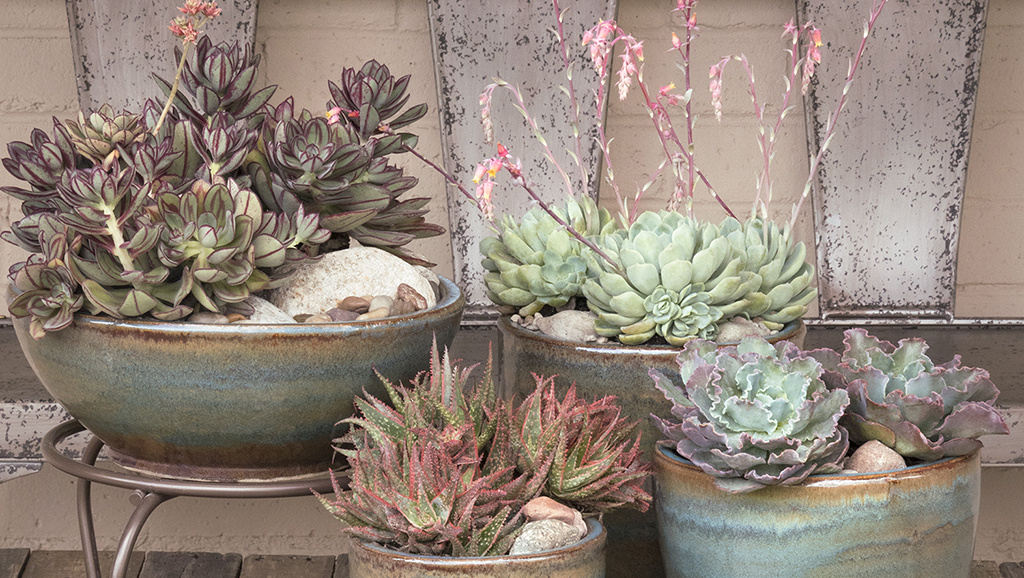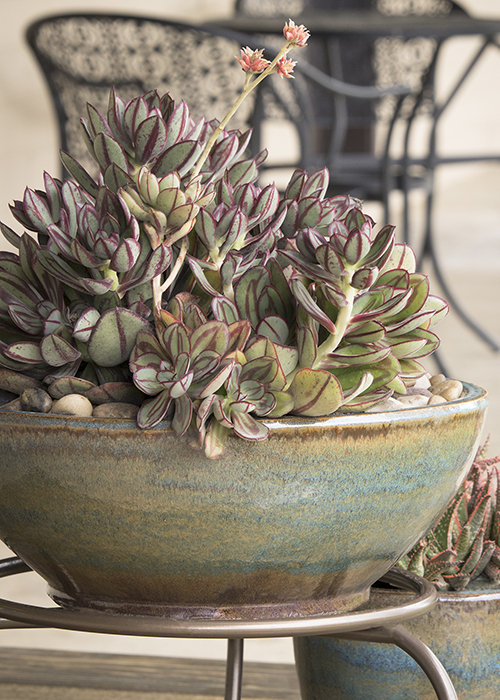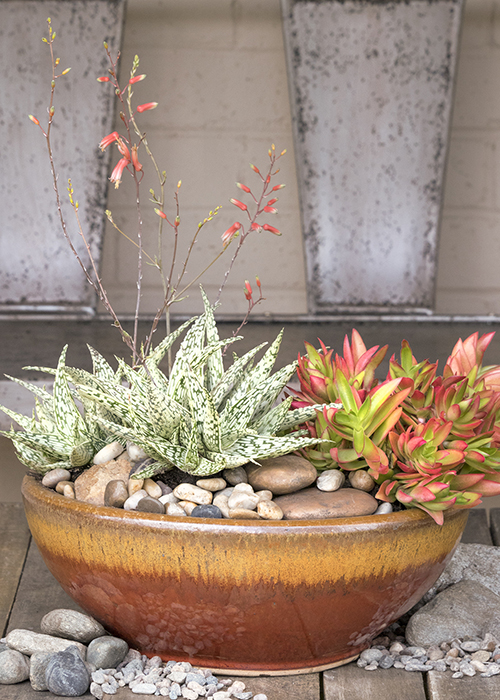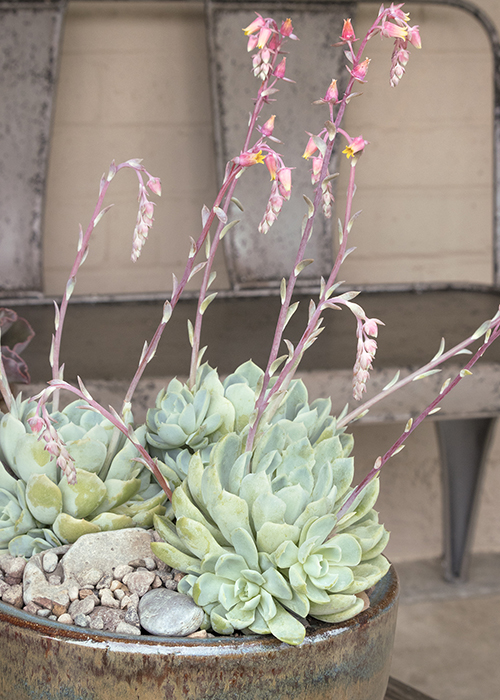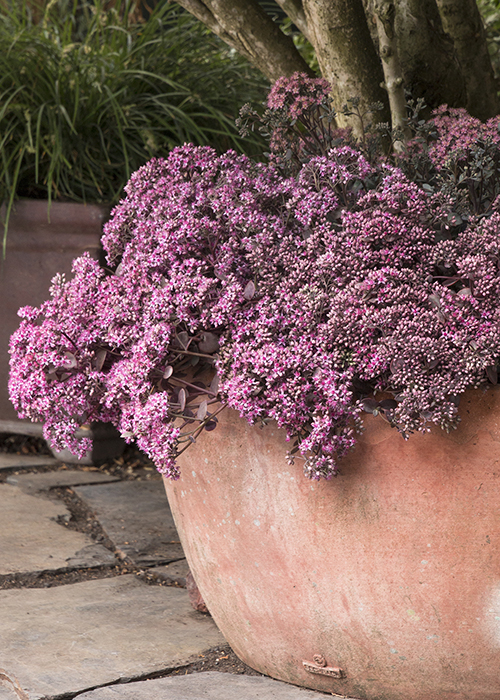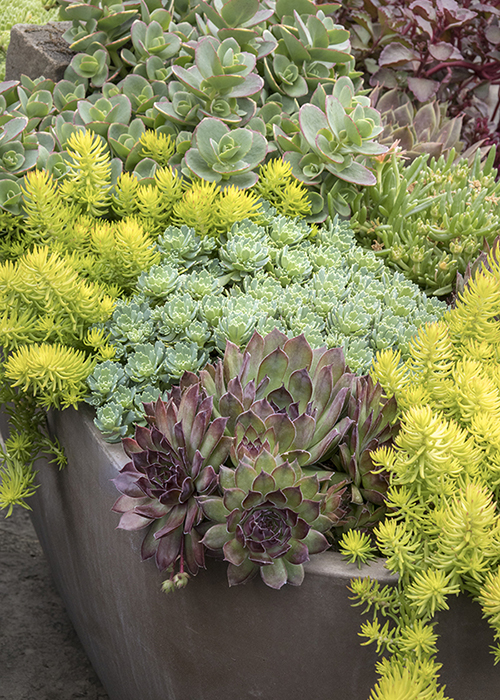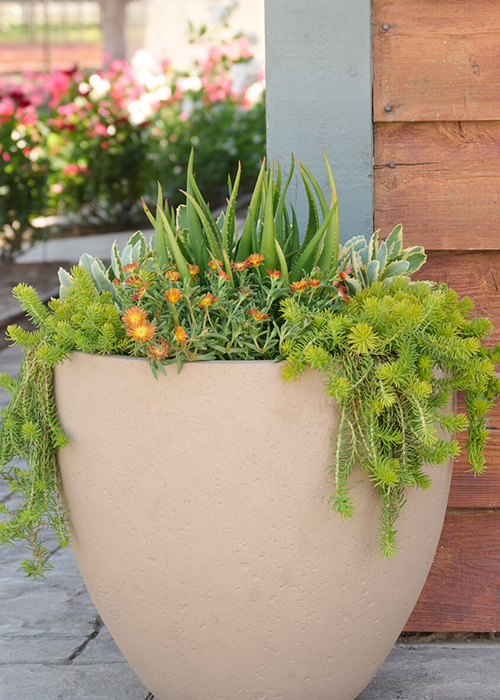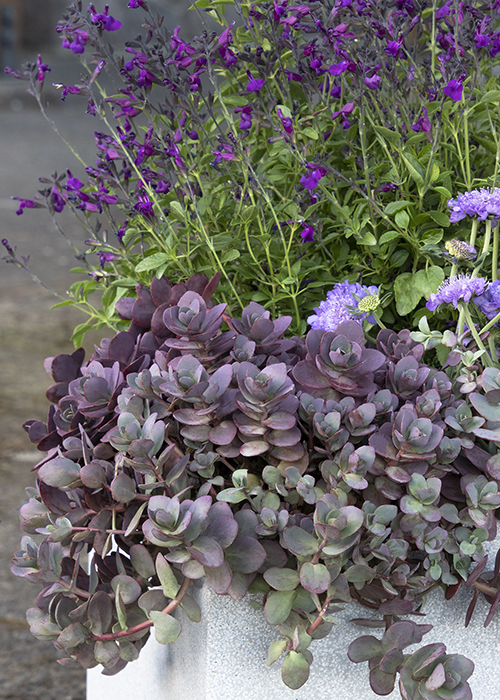With summer in full swing, there can often be fewer chores to occupy yourself with in the garden—tomatoes ripen on the vines all by themselves, flowers bloom even without your coaxing, and hot, lazy days abound. But if that green thumb of yours still wants to get some exercise, consider planting potted succulents.
(Above) Painted Echeveria, Mexican Snowball Echeveria, Christmas Carol Aloe, and Ruffles Echeveria in containers.
Story by Johanna Silver, author of The Bold Dry Garden: Lessons from the Ruth Bancroft Garden
Filled with architectural forms, great geometry, myriad colors and textures, and small statures, these potted beauties come together quickly and look great instantly. There’s no need to wait to enjoy the fruits of your labor. Succulents take a measly amount of water, perfect for the many regions of the country struggling with drought or that have reliably dry summers. Plus, they’re nearly maintenance-free, not adding any additional chores to the garden.
Because they’re so beautiful, they add the perfect finishing touch to any front door, patio, porch, or deck, or—if plants are small and containers shallow enough—an arrangement can even make a great centerpiece to your outdoor patio table, much like a vase of flowers would—but this one lasts much longer. The creation of a succulent arrangement can be the perfect one-day or weekend project to get your flexing your gardening muscle.
How to Plant and Care for Succulents in Containers
Painted Echeveria with Christmas Carol Aloe in the background
Succulent Container Considerations
Let’s get to the nitty gritty of making your succulent arrangement a success. As many succulents are small, you’ll want to get a container that doesn’t dwarf them with too large of a size. Succulents don’t need a lot of depth, so feel free to go with a container on the shallow side—6 to 8 inches is plenty deep.
A wide planter has more surface area to create a larger vignette of different types of succulents, whereas a smaller container is great for showing off one type at a time. Especially shallow containers, in particular, can make great tabletop arrangements, looking great on a patio table without blocking anyone’s view. Their geometric forms and supple leaves make great conversation starters at any summer soiree.
Succulent Watering 101
In their native habitat—dry desert locations all around the world—succulents grow in nooks and crannies and in outcroppings of rocks. These rugged locations have fast-draining soil that doesn’t hold a lot of moisture. For this reason, you’ll want to plant your succulents in a potting mix specifically designed for cactus (cactus are one subset of succulents). This ensures that your arrangement won’t rot due to excess moisture in the soil. Cactus mix is easy to source at any gardening store and often comes in small bags—perfect for a small succulent planting project.
Planting Succulents in Containers without Drainage
While containers with drainage are always best for the health of plants, it’s possible to grow a succulent arrangement in containers lacking holes in the bottom. If you’re going this route, be especially careful not to overwater, as water collecting at the bottom of the container can cause rot, making your plants die. You make place a layer of rocks at the bottom, but this isn’t necessary. Just be sure to wait until the soil is completely dry to water again. Water sparingly, making sure the top inch or two gets moist, but again, succulents are shallow-rooted, and you don’t need to make sure the entire container is saturated and dripping wet with water.
Let There Be Light (Or Part Shade)
Like humans, succulents have an array of what type of light they feel best in. Often, they’ll handle both full sun and partial shade. This is true for Angelina Stonecrop, Campfire Crassula, and Safari Rose Aloe. Part shade tends to be where they thrive the most. You’ll know they’re getting too much sun if their leaves get sunburnt or turn pale from overexposure.
Other succulents, like stonecrops and ice plants do great in the fullest of full sun situations. It’s best to keep your eye on the spot you’re planning to put your container display and monitor the light situation throughout the day for a few days before planting time. This information will help you with the selection process, and you can always add this info to our My Plantfinder tool to find the plants that will do best in your location.
To get a great succulent arrangement that looks full and lush, you’ll either want to fill the container entirely with plants—succulents love to be snuggled up against each other—or you’ll want to add a top dressing of small pebbles or stones to finish the look. Either of these approaches is great and looks finished and complete right away.
Succulent Container Design Ideas
The sky is truly the limit when it comes to designing succulent containers, as they can come together in any number of ways and in any number of color palettes and mix and match with each other or even different types of plants.
Start with Color Palette
A great starting point for your succulent container arrangement is color palette. For instance, perhaps you want to keep a pastel theme going. If so, reach for plants including Mexican Snowball Echeveria, Topsy Turvy Echeveria, or Maraca Portulaca.
Dramatic Contrasts
Or perhaps more stark contrasts and darker colors are your thing. If so, reach for plants like Painted Echeveria, Black Prince Echeveria, Lipstick Echeveria, and Kalinda Hens and Chicks.
Light and Bright
If bright flowers make your heart sing, you can’t go wrong with any number of ice plants, including Wheels of Wonder® or Jewel of Desert.
Then Decide How Many Plants Per Container
One-Plant Wonders
When it comes to design, you might opt for one plant per container to highlight each one as its own specimen. Some of our most eye-catching succulents to show off this way include Ruffled Red Echeveria, Zebra Plant, and Neon Breakers Hens and Chicks, but really any are interesting up close. These can stand alone as a one-container display, or they can be part of a collection of containers, each planted with one type of succulent. Be sure to cover the bare soil with pebbles or rocks for a finished look.
More is Better
One per container not your thing? You can do the more is better approach and combine lots of succulents together in the same container. Remember, being shallow-rooted, they have no qualms about cuddling up close right at planting time. Cover any bare soil with pebbles or rocks, or use another succulent, such as Angelina Stonecrop, Limelight Japanese Stonecrop, or John Creech Stonecrop as a sort of groundcover to fill in any blank spaces.
Get Creative with Non-Succulent Companions
Or you don’t even have to limit yourself to a succulent-only arrangement. These plants play perfectly well with other types of dry-adapted perennials and grasses. A pairing we’re crazy about is succulents and thrift.
Grab any rosette-shaped succulent, like Green Wheel Hens And Chicks, Pacific Blue Ice Hens And Chicks, Ruffles Echeveria (especially great because of its pink edging), and plant with pink-flowered thrift, such as Dreameria® Dreamland Thrift or Bloodstone Thrift. The pink puffballs atop the grassy-esque thrift look fantastic with the rounded succulent forms.
Experiment with flowering perennials
First, reach for any succulent with purple undertones, such as Neon Breakers Hens and Chicks, Perle von Nurnberg Echeveria, or Mission to Mars Mangave, and pair them with purple-flowered VIBE® Ignition Purple Salvia for an explosive summer container.
Or find succulents with pink undertones, including Afterglow Echeveria, Blue Prince Echeveria, or Desert Oasis™ Echeveria, and pair them with pink-flowered Harlequin™ Pink Beardtongue. Other great perennials to pair with succulents include, Kudos Coral Dwarf Agastache, VIBE® Ignition White Salvia, and Moonbeam Threadleaf Coreopsis.
Whichever you pick, the softness and looseness of the perennial provides an excellent foil to the rigid, statuesque form of a succulent. The combo keeps it more casual and adds movement and interest to any arrangement.
Pair with Grasses
We also love seeing succulents paired with grasses. Similar to perennials, grasses provide movement and contrast to the shape and form of succulents. Some of our favorite grasses to pair in containerized arrangements include Elijah Blue Fescue, Karley Rose Fountain Grass, and Blonde Ambition Blue Grama Grass.
Potted Succulent Winter Care
Many succulents are quite tender and will die or get severely damaged in frosts or freezes. A few, like most sedum and ice plants, can handle the cold of a proper winter. But many others, like aloe, agave, and aeonium need protection in the winter. Though they won’t be happy indoors year-round, it’s possible to bring these—and other tender beauties—indoors for the coldest months.
Before moving them inside, check for bugs and remove any dead leaves or decay on top of the soil. You’ll want them to be nice and clean in their new indoor homes. Keep them away from drafts and heat vents and locate them close to a bright window. Sun can sometimes amplify the heat so check on them to make sure they aren’t sunburnt.
On the other hand, if they start reaching for the window, it most certainly means that conditions aren’t bright enough for them to thrive. Bring them back outside when all chance of frost has passed, and the nighttime temperatures are staying above 40°F.
Get More Tips for Gardening in Hot, Dry Conditions
- Watch: Waterwise Gardening Webinar
- These Stunning Container Plants Can Take the Heat!
- Favorite Drought-Tolerant Plants
- Low Water, High Beauty Waterwise Gardening Digital Guide
- Favorite Drought-Tolerant Edible Plants
- U.S. Drought Monitor
- Heat-Tolerant Plants: Cool shades for hot gardens
- Sculptural Succulents for Warm and Temperate Climates
- Dry-Farmed Gardens
- 6 Easy Ways to Save Water In The Garden
- Summer Watering Tips
- Hot Season Heroes
- Cool Combo: White and Waterwise
- What's THAT: Aloe




